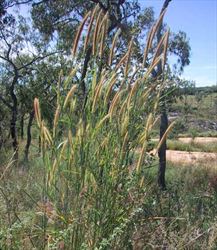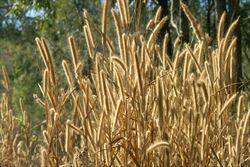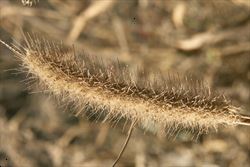Click on images to enlarge

habit (Photo: Chris Gardiner)

habit during the dry season (Photo: Chris Gardiner)

mature seed-heads (Photo: Chris Gardiner)

close-up of mature seed-head (Photo: Chris Gardiner)
Scientific Name
Cenchrus polystachios (L.) Morrone
Synonyms
Pennisetum polystachion (L.) Schult.
Cenchrus setosus Sw.
Panicum polystachion L.
Pennisetum polystachion (L.) Schult. subsp. setosum (Sw.) Brunken
Pennisetum polystachyon (L.) Schult.
Pennisetum setosum (Sw.) L. Rich.
Family
Gramineae (South Australia)
Poaceae (Queensland, New South Wales, the ACT, Victoria, Tasmania, Western Australia and the Northern Territory)
Common Names
blue buffel grass, elephant grass, feather pennisetum, feathery pennisetum, mission grass, missiongrass, thin Napier grass, West Indian pennisetum
Origin
This species is thought to be native to tropical Africa (i.e. Ethiopia, Kenya, Tanzania, Uganda, Cameroon, Gabon, Zaire, Benin, Burkina Faso, Ivory Coast, Gambia, Ghana, Guinea, Guinea-Bissau, Liberia, Mali, Niger, Nigeria, Senegal, Sierra Leone, Togo, Malawi, Mozambique, Zambia and Zimbabwe), but is now widespread throughout the tropical regions of the world (i.e. it is pan-tropical).
Cultivation
Mission grass (Pennisetum polystachion) has been widely cultivated as an ornamental throughout the tropical regions of the world, and this may have also been the case in northern Australia. However, it is known to have been one of several grasses introduced into Australia in the 1940's and 1950's for testing as pasture grasses.
Naturalised Distribution
This species is widely naturalised in northern and eastern Australia. It is most common in the northern parts of the Northern Territory and in northern Queensland. Also occasionally naturalised in central and south-eastern Queensland and in the southern parts of the Northern Territory.
Habitat
A weed of roadsides, waste areas, disturbed sites, crops, pastures, grasslands and open woodlands in the tropical, sub-tropical and semi-arid regions of Australia.
Habit
A tussock-forming long-lived (i.e. perennial) grass usually growing 2-3 m tall.
Distinguishing Features
- an upright tufted grass with branched or unbranched flowering stems growing up to 3 m tall.
- its long spike-like seed-heads (3-35 cm long and 6-26 mm thick) are yellowish in colour.
- these seed-heads consist of large numbers of densely packed stalkless flower spikelets (2-5 mm long).
- these flower spikelets are surrounded by numerous small feathery bristles (4-12 mm long) and one much larger bristle (6-25 mm long).
- seed-heads and seeds turn yellowish-brown or straw-coloured when mature and the seeds are shed still surrounded by the feathery bristles.
Stems and Leaves
The flowering stems (i.e. culms) are upright (i.e. erect or ascending), either branched or unbranched, and sometimes produce roots at the lower joints (i.e. nodes). Several of these round (i.e. cylindrical), hairless (i.e. glabrous), stems arise from the base of the plant (i.e. crown).
The leaves consist of a leaf sheath, which partially encloses the stem, and a spreading leaf blade. The leaf blades (5-45 cm long and 3-18 mm wide) are long and narrow (i.e. linear) and either hairless (i.e. glabrous) and smooth or somewhat hairy (i.e. pubescent) towards the base. Where the leaf sheath meets the leaf blade there is a fringe of hairs (i.e. ciliated ligule) 1.5-2 mm long.
Flowers and Fruit
The long spike-like (i.e. spiciform) seed-heads are actually spike-like panicles with very short side branches. These seed-heads (3-35 cm long and 6-26 mm across) are held upright (i.e. erect) or are slightly drooping in nature. One or sometimes more of these seed-heads are borne at the top of the flowering stems (i.e. culms). They are yellowish-green to brown in colour (mostly yellow) and consist of large numbers of densely packed, stalkless (i.e. sessile) flower spikelets. Each of the flower spikelets (2-5 mm long) is surrounded by numerous feathery bristles (mostly 4-12 mm long). However, one of these bristles is significantly longer than the others (6-25 mm long). Flowering occurs mainly from late summer through to early winter, though some seed-heads may begin to appear with the first rains in spring.
The mature seed and seed-heads turn yellowish-brown or straw-coloured. Each seed is 3-5 mm long and is shed from the seed-head with the bristles (i.e. involucre) still surrounding it. Mature seed-heads are present mostly during winter (i.e. from April to June).
Reproduction and Dispersal
This species generally only reproduces by seeds. These light and fluffy seeds are dispersed by animals, water, wind and become attached to clothing and vehicles. They may also be spread as a contaminant of agricultural produce (e.g. in hay and grain).
Environmental Impact
Mission grass (Cenchrus polystachios) is a potentially significant environmental weed in northern Australia, where it is currently listed as a priority environmental weed in three Natural Resource Management regions. It is already having a significant impact in the northern parts of the Northern Territory and is actively managed by community groups in this region.
Once established, mission grass (Cenchrus polystachios) has a competitive advantage over short-lived grasses and replaces native species, threatening natural biodiversity. The main impact this exotic grass has on native vegetation is the change it can have on the fire regime. The above-ground parts dry off each year and, being very robust in nature, they have very high fuel load. This results in extremely hot fires late in the dry season which carry flames into the canopy of trees. These wildfires accelerate its invasion into native bushland and can result in the death of trees and the replacement of the natural savannas with exotic grasslands.
The first observations of mission grass (Cenchrus polystachios) as a weed in the Northern Territory were in the Darwin area in 1970, where it was already well established, and the first herbarium collection was made in 1974. It has subsequently spread south to Katherine, east into Arnhem Land, southwest to the Daly River and north to the Tiwi Islands. The invasion of Mission grass (Cenchrus polystachios) and other exotic grasses in the Wildman and Mary River catchments, and in Kakadu National Park, is also known to be threatening the survival of some native animals. For example, it has caused a decline in the quality of the habitat available to the endangered yellow-snouted ground gecko (Diplodactylus occultus), making its geographic distribution precarious for its survival.
Other Impacts
Mission grass (Cenchrus polystachios) is an important roadside weed in the coastal districts of northern Australia and in commonly seen as a dense monoculture on roadsides in the Northern Territory. It also invades cultivation, wastelands and pastures. In the Northern Territory it has been reported to reduce the yield of summer crops (e.g. sorghum, maize and cotton) and the viability of sown pastures.
Legislation
This species is declared under legislation in the following states and territories:
- Northern Territory: B - growth and spread to be controlled (throughout all of the territory), and C - not to be introduced into the Territory.
- Western Australia: Prohibited - on the prohibited species list and not permitted entry into the state.
Management
For information on the management of this species see the following resources:
- the Northern Territory Department of Natural Resources, Environment and The Arts Agnote on this species, which is available online at http://www.nt.gov.au/weeds.
Similar Species
Mission grass (Cenchrus polystachios) is very similar to African feather grass (Cenchrus macrourus), Deenanth grass (Cenchrus pedicellatus) and swamp foxtail (Cenchrus purpurascens) and relatively similar to elephant grass (Cenchrus purpureus), fountain grass (Cenchrus setaceus) and feathertop (Cenchrus longisetus). These species can be distinguished by the following differences:
- mission grass (Cenchrus polystachios) is a large long-lived (i.e. perennial) grass (usually 2-3 m
tall) with very elongated, yellowish or brownish-coloured seed-heads. The main
stem (i.e. rachis) of the seed-head is angular and the relatively long
bristles (4-25 mm long) are hairy (i.e. plumose).
- African feather grass (Cenchrus macrourus) is a large long-lived (i.e.
perennial) grass (usually 1-2 m tall) with very elongated, greenish or
yellowish-coloured seed-heads. The main stem (i.e. rachis) of the seed-head is
rounded and the relatively short bristles (mostly less than 10 mm long) are
rough (i.e. scabrous).
- Deenanth grass (Cenchrus pedicellatus) is a moderately-sized short-lived (i.e. annual or
perennial) grass (usually 30-150 cm tall) with elongated, pale
purplish-coloured seed-heads. The main stem (i.e. rachis) of the seed-head is
angular and the relatively long bristles (6-24 mm long) are hairy (i.e.
plumose).
- swamp foxtail (Cenchrus purpurascens) is a moderately-sized long-lived (i.e. perennial) grass
(usually 60-100 cm tall) with relatively elongated, purplish-coloured
seed-heads. The main stem (i.e. rachis) of the seed-head is rounded and the
relatively long bristles (15-30 mm long) are hairless (i.e. glabrous).
- elephant grass (Cenchrus purpureus) is a very large and robust long-lived (i.e. perennial) grass
(1-7 m tall) with elongated, greenish or purplish-coloured seed-heads. The
main stem (i.e. rachis) of the seed-head is rounded and the relatively long
bristles (10-16 mm or more long) are rough or hairy (i.e. scabrous to
plumose).
- fountain grass (Cenchrus setaceus) is a moderately-sized long-lived (i.e. perennial) grass (50-150
cm tall) with relatively elongated, reddish or pinkish-coloured seed-heads.
The main stem (i.e. rachis) of the seed-head is angular and the long bristles
(up to 25 mm or more) are hairy (i.e. plumose).
- feathertop (Cenchrus longisetus) is a relatively small long-lived (i.e. perennial) grass (15-100 cm tall) with relatively broad, oblong-shaped, whitish-coloured seed-heads. The main stem (i.e. rachis) of the seed-head is angular and the very long bristles (30-70 mm long) are hairy (i.e. plumose).

